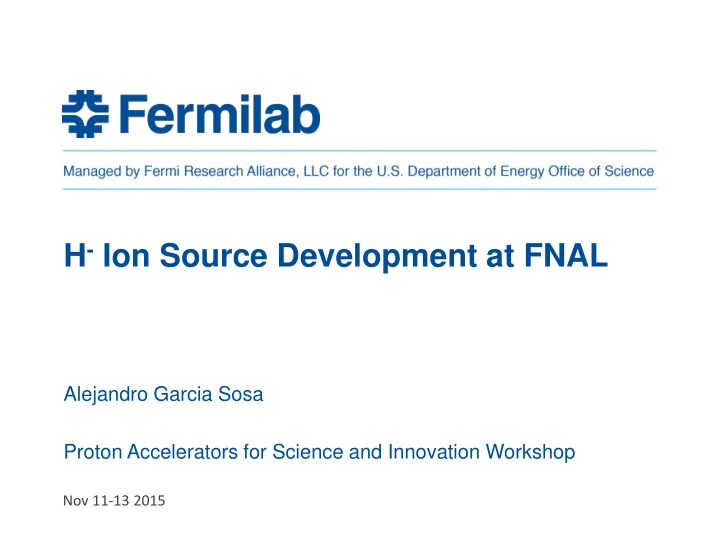

H - Ion Source Development at FNAL Alejandro Garcia Sosa Proton Accelerators for Science and Innovation Workshop Nov 11-13 2015
Outline • Magnetron Source • Work done on operational sources – Beam Neutralization – Fiber Optics Chassis – Electron Microscope Studies • Experiments on the test stand – Solenoid Valve – Gas Mixing Experiment – Tungsten Dimple Cathode – Cs delivery system • A look into the future: PIP-II Linac • Conclusions H - Ion Source Development at FNAL | Proton Accelerators for Science and Innovation Workshop 2015 2
FNAL H- Ion Source Current FNAL H - Source parameters Parameter Value Units Arc Current 15 A Arc Voltage 180 V Extractor Voltage 35 kV Beam Current 80 mA Power Efficiency 48 mA/kW Rep Rate 15 Hz m s Arc Pulse Width 250 m s Extracted Beam Pulse Width 80 Duty Factor 0.375 % Cathode Temperature 380 °C 9 months of continuous Cs Boiler Temperature 130 °C Emittance e x / e y (norm., 95%) p mm mrad 0.17/0.28 operation! 4.67 mm Extraction Gap 9 months Lifetime H - Ion Source Development at FNAL | Proton Accelerators for Science and Innovation Workshop 2015 3
Beam Neutralization M. Reiser et al, "Theory and Design of Charged Particle Beams", 2nd Ed., pg. 243-254, Wiley- VCH, 2008. H - Ion Source Development at FNAL | Proton Accelerators for Science and Innovation Workshop 2015 4
Fiber Optics Chassis Fiber Optics HRM • Removed HRM from the HV rack • Replaced by fiber optics communications link • Reduced overall spark rate due to asynchronous rebooting of HRM • Standardization of operational sources • More stable operations H - Ion Source Development at FNAL | Proton Accelerators for Science and Innovation Workshop 2015 5
Electron Microscope Studies • Aim: Analysis of black residue in source B components (9 month run) • Silicon, Oxygen and Molybdenum identified • Cathode material is Mo • Insulators are Macor -> Silica SiO 2 H - Ion Source Development at FNAL | Proton Accelerators for Science and Innovation Workshop 2015 6
Test Stand H - Ion Source Development at FNAL | Proton Accelerators for Science and Innovation Workshop 2015 7
Gas Mixing Experiment • Aim: Study effect on beam current noise • Active mixing: gas mixture can be dynamically adjusted • Mass Flow Controllers make use of pressure drop in a laminar flow (10 - 15 psi) Chaco, E., Moehs, D., & Schmidt, C. W. The Effects of Nitrogen Gas on the Production of Negative Hydrogen Ions. Fermilab SIST Program . H - Ion Source Development at FNAL | Proton Accelerators for Science and Innovation Workshop 2015 8
Problems with Piezoelectric Valves • Veeco PV-10 piezoelectric valves • Very sensitive to temperature changes • Affects the arc current and vacuum pressure H - Ion Source Development at FNAL | Proton Accelerators for Science and Innovation Workshop 2015 9
Problems with Piezoelectric Valves ~1 A ~1 ° C H - Ion Source Development at FNAL | Proton Accelerators for Science and Innovation Workshop 2015 10
Solenoid Gas Valve • Aim: Study feasibility of using these valves to tune the source • Less sensitive to temperature changes H - Ion Source Development at FNAL | Proton Accelerators for Science and Innovation Workshop 2015 11
Tungsten Dimple in Source Cathode • Aim: Analyze the performance of the source running with a W dimpled inserted in the Mo cathode • W provides a broader H - production peak than Mo • If source runs successfully: Production of a full W cathode Figure from ZHANG Ion Sources H - Ion Source Development at FNAL | Proton Accelerators for Science and Innovation Workshop 2015 12
Tungsten Dimple in Source Cathode H - Ion Source Development at FNAL | Proton Accelerators for Science and Innovation Workshop 2015 13
Cs delivery system If Cs layer is too thick/thin: • Work function increases • Decreased H- production • Increased number of free electrons H - Ion Source Development at FNAL | Proton Accelerators for Science and Innovation Workshop 2015 14
Cs delivery system • We currently use 5 g Cs glass ampoules • Cs is often trapped in the glass shards H - Ion Source Development at FNAL | Proton Accelerators for Science and Innovation Workshop 2015 15
Cs delivery system • Better temperature control • No-ampoule boiler H - Ion Source Development at FNAL | Proton Accelerators for Science and Innovation Workshop 2015 16
A look into the future: PIP-II Linac – Output Energy: 800 MeV – Rep. rate: 20 Hz Derwent, P., Holmes, S., & Lebedev, V. (2015). An 800- – Beam pulse: 0.55 ms MeV superconducting LINAC to support megawatt proton – Beam current: 2 mA operations at Fermilab. – Able to run CW H - Ion Source Development at FNAL | Proton Accelerators for Science and Innovation Workshop 2015 17
Conclusions • 9 month run is a big achievement • Continue improving the sources (stability/reliability/performance) • Test stand up and running H - Ion Source Development at FNAL | Proton Accelerators for Science and Innovation Workshop 2015 18
Thank you! H - Ion Source Development at FNAL | Proton Accelerators for Science and Innovation Workshop 2015 19
Backup Slides 20 Presenter | Presentation Title 11/10/2015
Piezoelectric Valves 21 Presenter | Presentation Title 11/10/2015
Recommend
More recommend